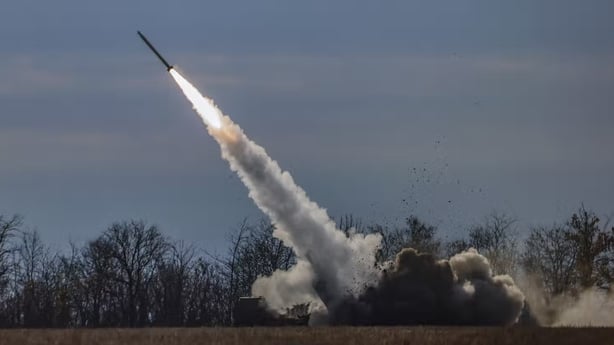US President Donald Trump has announced an intention to "pause and review" military aid for Ukraine, leading to discussion about how badly the withdrawal of such support in the medium-term would impact Ukraine's defence against Russia.
So how much does the US give Ukraine, how does the spending break down, and how important is it for Ukraine?
The United States is by far the biggest single contributor of support to Ukraine. Last week, we broke down what the US has given Ukraine in aid compared to Europe, noting various other countries provide more as proportion of their economy.
In total, €267 billion in bilateral aid has been allocated to Ukraine from donor countries, according to data from the Kiel Institute for the World Economy. Of the total €267bn, which has been delivered or specified for delivery, the US has given €114bn, with a further €4bn committed but not yet allocated.
The Kiel Institute's database, the Ukraine Support Tracker (UST), collates figures on military, financial, and humanitarian aid allocated by countries around the world since diplomatic ties with Russia ended on 24 January 2022.
Of that €114bn in US support, €64bn has been given in military aid, with a further €1.4bn to be allocated.
That is almost exactly half the €129bn committed to Ukraine for military aid from international donors overall.
The US is followed closely by Europe, as a geographical bloc, albeit Europe has committed a further €38bn which has yet to be allocated to specific contracts or equipment.
We need your consent to load this flourish contentWe use flourish to manage extra content that can set cookies on your device and collect data about your activity. Please review their details and accept them to load the content.Manage Preferences
When tracking military aid, it should be noted that the UST does not include the estimated cost of activities such as training Ukrainian soldiers, which often happens outside of Ukraine.
What is the US military aid being spent on?
According to the UST, of the €64bn of US military aid given to Ukraine, it is estimated that around €13.7bn has been spent on heavy weaponry.
This includes things like armored vehicles, tanks, and howitzers. Other money has been spent on ammunition, artillery shells, smaller arms and equipment, which the US has also provided.
Specifically, the US provides significant support to Ukraine’s air defences, including three Patriot Surface to Air Missile (SAM) systems which can shoot down incoming missiles or aircraft; 12 other SAM units, and 3,000 Stinger anti-aircraft missiles.
The Stinger is a shoulder-mounted heat-seeking rocket launcher which can be used to attack aircraft and drones. It became famous during the Soviet-Afghan war of the 1980s, when it was used against Soviet helicopters.
This kind of equipment is particularly important given the nature of the war and the frequency of air attacks and strikes from Russian forces.
The US has also sent more than 40 HIMARS, mobile long-range precision rocket launching systems which have been used against infrastructure and military locations, as well as howitzers, and hundreds of thousands of artillery rounds.

Notably, 10,000 Javelins - weapons which are similar to Stingers but used against tanks and armoured vehicles - have also been supplied via the US.
In a post on X aimed at helping to repair US-Ukraine relations, Ukrainian President Volodymyr Zelensky noted the value of Javelins particularly to his forces, and how they were initially provided to Ukraine during President Trump’s first term in office in 2018.
"We do really value how much America has done to help Ukraine maintain its sovereignty and independence. And we remember the moment when things changed when President Trump provided Ukraine with Javelins. We are grateful for this," he said.
While the US "pause and review" has been announced, it appears sharing of intelligence is continuing, according to the Reuters news agency. As is Ukrainian access to the Elon Musk-owned Starlink system, the satellite communications network crucial to ensuring secure communication, coordinating drone operations, and executing strikes.
Without Starlink, forces on the frontlines could have to resort to radio communications, which would massively hamper their capabilities.
Speaking to RTÉ's Morning Ireland, Dr Frank Ledwidge, Senior Lecturer in Strategy at Portsmouth University, said access to Starlink and intelligence is vital.
"The more important step by the Americans, which would really force the Ukrainians to the table immediately, isn’t the halt in military assistance... it would be their assistance in respect to intelligence, reconnaissance, and communications. That would be terminal for the Ukrainians."
The European Commission, UK, France, and several European satellite providers have reportedly been in discussion on potential replacement systems, in case Starlink services become unavailable to Ukrainian forces.
Similarly, European countries are also trying to devise ways to fill the gap which will open up if the US military aid 'pause' becomes a long-term stoppage.
European companies may be stymied in doing so by the terms of their production licensing, if they are manufacturing US-designed armaments.
As Serhiy Rakhmanin, a Ukrainian politician, told Reuters much will depend on whether the United States decides to block producers that hold US production licences and are ready to continue supplying Kyiv with weapons and ammunition.
"If our European partners have the freedom to act, if they have the time, the desire, the money and the ability to help us, this will not be a disaster," he said.
The pause in US aid a devised currently will not have a sudden impact on the war or its frontlines, but it will have a real impact if remains in place over months.
In the meantime, each day and night, air defence missiles will be used to prevent incoming fire over Ukrainian cities and positions, and tank shells will be launched at Russian forces.
When or if a replacement will come for each missile, shell, and bullet, is now in question.







